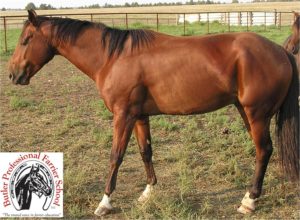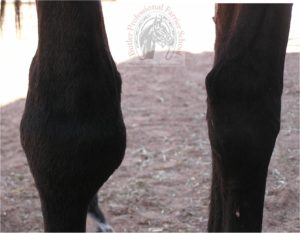Horses in Pain

Farriers should learn to recognize the signs of pain in horses. Note that this horse’s eyes and mouth are tight. The left front leg is pointed forward, indicating that the horse has pain in the heel (typical stance of a horse afflicted with Navicular syndrome).
Farriers and veterinarians alike have (or should have) the horse’s welfare in mind. We do our best to make horses comfortable and would never purposefully harm a horse. We want the horse to be safe. We want the horse to be healthy. We do not want the horse to hurt! It would be nice if horses could speak (or at least if more horse practitioners could understand what they are saying) for then we would know exactly what is ailing the horse. There is little research as to how the horse perceives pain. The problem with pain in horses is that there isn’t a consistent way to measure it or quantify it. And even if there was, that measurement would be skewed by subjective data from individual horses with different experiences. Horses, like people, react to pain differently. Without measurements there is no science.
Some horses have a higher pain tolerance than others. The same is true of humans. Doctors use a scale of 1 to 10 to determine how much pain a person is in (1 being little to no pain and 10 being extreme pain). But one person’s pain rating of 3 might be another’s 8. Someone conditioned to pain might break an arm and rate the pain at a 4. Yet someone who rarely experiences pain might get a paper cut and rush to the emergency room for pain killers. An independent horse in an enormous amount of pain might not exhibit it because of its nature (doesn’t want to be perceived as weak to others in the herd) whereas another horse that is coddled might get a minor sole bruise and exhibit extreme signs of lameness. Some horses that have been in pain for a long period of time find ways to cope with it and stop showing signs.
Several years ago, my mom was horseback riding. She was thrown from the horse and broke her back in several places. I called an ambulance and when the paramedics arrived they asked her what her pain level was on a scale of 1 to 10. My mom (not knowing yet that her back was broken) said, “Maybe a 5?” What the paramedics didn’t know is that my mom had given birth to seven children in her lifetime so relatively a broken back might not have seemed that bad! If it had been me, I might have said a 10 or an 11.
There is a tendency to blame the feet or the shoes if the horse seems to exhibit signs of pain or discomfort especially because those signs aren’t obvious to the unskilled eye until the horse moves (walk, trot, etc.) But equine practitioners would do well to look at the horse holistically before making such a limiting diagnosis. It would seem silly to anyone if a person had kidney stones and was hunched over and walking in an abnormal gait because of the pain and the doctor says, “It is probably the shoes that are bothering him. Get him some new shoes.” As ridiculous as that sounds, many inexperienced horse people are doing exactly that when they see a lame horse. Sometimes, we are too quick to judge. We need to get in a habit of looking above the feet and see that there is an animal attached up there with a possibility of all kinds of ailments.
My dad shared this story with me about the importance of looking the whole horse over. He was called upon to look at a horse that was lame and the legs were swelling up. Naturally, everyone that looked at the horse was looking at the legs and feet. The horse was not very well trained and during a recent shoeing, the horse had reared up and thrown itself down in the work area and scattered tools and nails everywhere. The subsequent swelling in the legs was blamed on the recently applied shoes. As my dad, went to check the horse out, he ran his hand over the horse’s back and felt something abnormal in the horse’s sacral area. There was a horseshoe nail stuck in the horse’s back that was causing swelling, not only in the legs, but other parts of the body as well!

This horse’s lameness was blamed on the feet, but the swollen popped knee (caused by over-exertion and distention of the capsular ligaments within the knee) is more likely the cause of lameness.
Recently, a man brought a horse to us complaining of the horse’s lameness. He said that the horse was dragging his toe and that he must have Navicular syndrome. He wanted the horse to be put in aluminum, wedge heeled egg bar shoes immediately. He had loaded the horse in the trailer and driven a few hours to get to us. When he opened the trailer door, the first thing we noticed was that the horse had an enormous popped knee on the leg that the man was complaining about. We directed his attention to it and asked if he thought that might be part of the problem. Embarrassed, he admitted that he hadn’t even noticed the knee. Aluminum shoes would not have solved this horse’s problem.
To avoid this kind of embarrassment and more importantly, to best help the horse, we need to look over the whole horse. We need to take time to look for signs of pain or determine how we can help. Here are a few things we can do:
1) Look over the whole horse as well as run your hand over the horse, feeling it. Sometimes, by feeling the horse you will “see” things with your hand that might otherwise be invisible to a naked eye or could be obscured by a heavy or winter coat. Often times a bowed tendon may be difficult to see but easy to feel.
2) Observe the horse to see where it seems most uncomfortable or what triggers pain. A while ago, I was trimming a horse that was behaving very well and suddenly it started fighting me when I would lift the hind feet. A student that was working nearby noticed that the horse seemed to wince and “tighten up” in the back every time I went to pick up a hind leg. This student also knew something about equine chiropractic therapy and as she felt the horse’s back, she found that a vertebrae was out of alignment causing the horse pain when it lifted the hind legs.
3) Listen to the owner or the person who is with the horse the most. He or she will know the horse better than anyone else and can offer insights as to what the horse has been up to recently (if it has been eating, drinking, in a new pasture with new plants, kicking the stall, fighting with another horse, etc.)
If we take time to follow these steps, we will be able to better determine where the horse’s pain is originating and get them the help they need from the veterinarian or the farrier. Even though pain is immeasurable, horses should have their pain addressed whether it is a 2 or a 10 on a pain scale because horses react so differently to pain. Something that seems like a small problem could become worse if the horse doesn’t handle pain very well and the issue isn’t addressed. Because we have the horse’s welfare in mind, the amount of pain the horse is in may be less important than determining what the cause is and how to help the animal.

This horse suffered from a painful quarter crack on the right front foot. Left: Before shoeing, the horse is in a “braced” stance and putting more weight on the three feet that don’t hurt. Note the tightness of the mouth and eyes. Middle: The same day, after being shod with a heart-bar shoe to take the weight off of the painful area, note that the horse’s stance has changed and already looks more relaxed. Right: After six to eight weeks of wearing the therapeutic shoe, the horse looks more balanced and has a brighter disposition now that he is pain-free.
Related Posts
-
-
Do farriers use their brains? Some people incorrectly assume...Mar 08, 2018 / 0 comments
-
Farriers can get annoyed with people that they feel are unju...Nov 16, 2017 / 0 comments
Blog Categories
- Anatomy
- Best Business Practices
- Conformation
- Current Events
- Customer Service
- Draft Horse Shoeing
- Equine Soundness
- Essential Anatomy Kit
- Farrier Careers
- Farrier training
- Foal soundness
- Horse Care
- Horse Foot Care
- Horse Owner Tips
- Horsemanship
- Horseshoeing
- Horseshoeing History
- Iron and Forge Work
- Student Spotlight
- Uncategorized
- Veterinary Care
Blog Archives
Contact Us
Butler Professional Horseshoeing School
495 Table Road
Crawford, NE 69339
(800) 728-3826
jacob@dougbutler.com
Subscribe to Our Blog
Get Our Free e-Book!
If you think you want to become a farrier (or know someone who does), this book can help you make that decision. Horse owners will learn the importance of choosing a qualified farrier and how to select the “right” one.
[ Get the e-Book Now! ]
- Follow:
